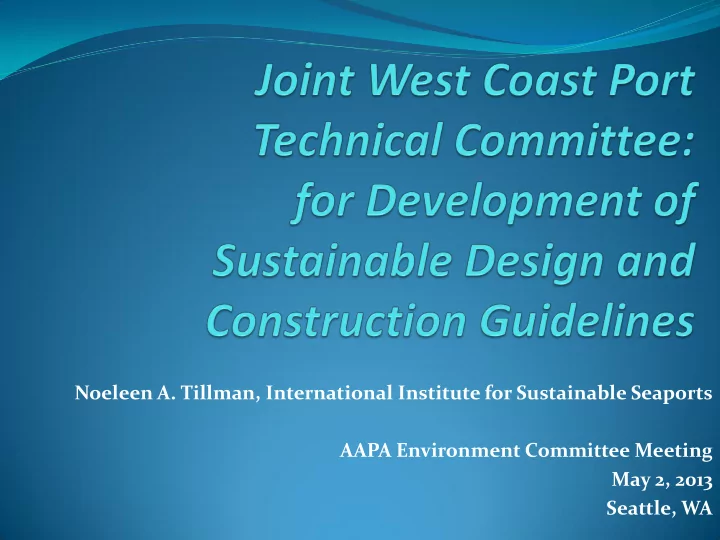

Noeleen A. Tillman, International Institute for Sustainable Seaports AAPA Environment Committee Meeting May 2, 2013 Seattle, WA
Presentation Overview Background What is the Joint West Coast Port Technical Committee? Who are the members? Why was it formed/purpose? Approach/Methodology Milestones to Date Path forward and Launch Date for Guidelines
What is the West Coast Ports TC? An innovative, collaborative effort of seaports varying in size, mission and location along the West Coast of US Composition is senior environmental planning and engineering staff Active, engaged participation
Cont’d Facilitated by the International Institute for Sustainable Seaports (I2S2) Neutral, not for profit partnership between American Association of Port Authorities (AAPA) and the Global Environment & Technology Foundation (GETF) Structure based upon previous, successful collaborative AAPA/GETF approach Builds off an economy of scale of a larger group where: each member contributes a small amount of funding to offset costs of facilitation and development of product meetings are hosted on a rotating basis
Mission To work collaboratively to develop a set of Sustainable Design and Construction Guidelines: To better serve the industrial objectives of West Coast ports, and the greater, world-wide port community
Members: Port of Long Beach Port of Seattle Port of Los Angeles Port of Tacoma Port of Portland Port of Vancouver Port of San Diego **International Institute for Sustainable Seaports (as facilitator)
Why focus on: Sustainable Design & Construction Guidelines? Increased growth and expansion at ports Impacts on surrounding communities Need to maximize economic, social and environmental benefits
Cont’d Minimizing impacts to the environment and communities New development at ports must require sustainable development practices for “license to operate” Currently, no other comprehensive guidance available: “Necessity is the Mother of Invention”
Prior Progress Leaders have made policy declarations Some procedures and plans in place Isolated but not consistent project results Organizational challenges defining roles, responsibilities
Committee Objectives: Define sustainable marine industrial development at the project level; Allow for flexibility and adaptability by individual ports; Build upon the sharing of best practices, keys to success, and lessons learned for implementation; Indentify options and opportunities to implement sustainable attributes;
Objectives (con’t) Establish objective guidance and measurement of port sustainability; Provide a consistent approach to sustainable maritime industrial development across the enterprise; Establish a common language that is understood by internal and external port stakeholders; and Enhance the overall efficiency, productivity, and environmental performance of each port without disadvantage to the other ports
Approach/Methodology Mandatory participation by all members Quarterly in-person day-long working sessions Monthly update conference calls Phased product development Clearly defined deliverables Identified target deliverable dates and milestones
Guideline Components: Air Transport Public Outreach Safety/Security Water Waste Energy Natural resources Materials Economic Maintenance, Considerations Monitoring, Reporting
Guideline Components: Dredging/Disposal and Geotechnical Soil Landfill Improvements Wharf Construction Traffic Management Roadways, Rails & Bridges Technology Projects Stormwater Marina Development Landscaping Dike construction Utilities Systems Land/Industrial Development Demolition Renewable Energy Revetment Installation Terminal Construction Bulk Storage Remediation Projects Oil and Gas Facilities Habitat
Example Worksheet
Example Summary Sheet
Path Forward Complete coding of technology tool (excel platform) Pilot use of draft Guidelines for several member port projects “Crowd - Source” use of draft Guidelines among port community through multiple outlets Refine, update and publish Release Date: August 2013
Thank You Noeleen A. Tillman International Institute for Sustainable Seaports Noeleen.tillman@getf.org 760.212.4119
Recommend
More recommend